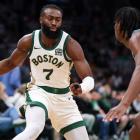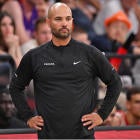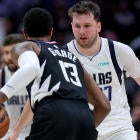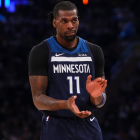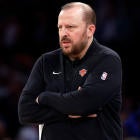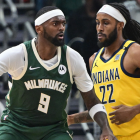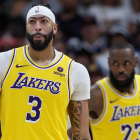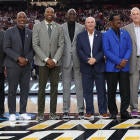The most mysterious story in next month's NBA draft isn't whether the Boston Celtics try to trade the No. 1 overall pick or take Washington's Markelle Fultz. It's not a story about how one of the most loaded drafts of the one-and-done era will turn out in the NBA, or about whether this will end up as the deepest point guard draft of all time, with Fultz, UCLA's Lonzo Ball, Kentucky's De'Aaron Fox and N.C. State's Dennis Smith poised to become stars.
The most mysterious draft story is this: Will the team that chooses Duke freshman Harry Giles -- somewhere middle to late in the first round, I would imagine -- turn out to be geniuses? Or will they turn out to have wasted one of the most important assets in the NBA with a first-round pick that went up in flames?
This is because Giles, a once-captivating young talent who suffered two torn ACL injuries before his 18th birthday, is the biggest risk-reward pick in an NBA draft since the Philadelphia 76ers picked Kansas' Joel Embiid with the third pick in 2014.
On one hand, the idea of drafting a near-Embiid-level talent in the middle of the first round is something that'll make NBA teams drool. Take, for example, one of Embiid's best games as a pro, in a close January loss to Houston. The big man scored 32 points, just shy of a career high, made 4 of 6 3-pointers, pulled down seven rebounds and added two blocks, three steals and four assists. There aren't many seven-footers in NBA history capable of performances like that.
But on the other hand, that Jan. 27 game was Embiid's final game of the season because of injury. In three seasons with the 76ers, he's played in exactly 31 games. Like Giles today, NBA teams knew the risk-reward scenario when Embiid was getting drafted. It's why I wrote before the loaded 2014 draft that Embiid could become one of two players: Hakeem Olajuwon, the future Hall of Famer taken with the first pick in the 1984 draft, or the player taken after Olajuwon in the same draft, Sam Bowie, whose injury-addled career turned Bowie into arguably one of the biggest draft disappointments in history (getting selected before Michael Jordan and Charles Barkley didn't help that legacy). And three years after Embiid was taken with the third pick, I still don't know if he'll become Olajuwon or Bowie.
This is the conundrum for a team enamored with what Giles once was and could someday once again become: The risk is as great as the reward.
"You're taking a bet on a kid because he has the tools and is naturally gifted, but you don't know exactly what you're getting," one Western Conference front-office executive said. "He's a bit of a mystery and such a challenging evaluation. A couple years ago he was one of the most impactful players out there at his age and in his class. If you feel like you have a pretty deep team and you're looking to take a flier on a kid who does have legitimate upside if he can put it all together and stay healthy, I do think he's easily a high first-round talent. But there's also a ton of risk there. If you're a team that's a young up-and-coming team and looking to add guys who are more ready to play now, maybe there's too many question marks on Harry."
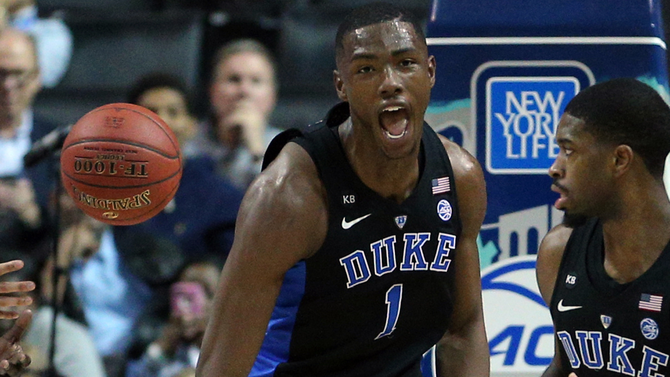
If you watched Giles in his one season playing for Coach K at Duke, you're probably wondering what all the fuss is about. Giles averaged 11.5 minutes as a reserve in only 26 college games. He averaged fewer than four points and four rebounds. He scored in double figures only twice. He often seemed lost on both ends of the court -- like any freshmen who missed all his preseason practices where he could get up to speed on the college game -- and he looked like a tentative, scared athlete who still didn't know how those knees were going to hold up.
But for those who only saw Giles in his forgettable season at Duke, let me tell you a story. In the summer of 2015, 17-year-old Harry Giles flew to Greece to compete in the FIBA Under-19 World Championships. He was one of the younger players in the tournament, and he was a wunderkind. He averaged 14 points -- tied for tops on the gold medal-winning American team -- and 10.6 rebounds, second in the tournament. He was named to the all-tournament team. His numbers were better than Jayson Tatum and Josh Jackson, both considered surefire top-five picks in next month's draft. More impressive than his stats were scouts' whispers about Giles' dominance. One respected talent evaluator pulled me aside during the Under-19 team tryouts in Colorado Springs. It was days before the 2015 NBA draft. He told me that, if a rising high school senior were eligible for the NBA draft, he'd pick Giles over Kentucky's Karl-Anthony Towns.
The kid was that good; just jaw-droppingly good.
A few months later, the bottom fell out, when he tore an ACL for the second time. When I heard the news I got sick to my stomach: Such an enormous talent, and such a bubbly, joyful, authentic young man, and he had to go through the struggles of injury recovery all over again. I remembered my past conversations with him: When he spoke wide-eyed about Coach K walking into his family's house. When he giggled after I told him how impressed a scout was by his play. When he told me about a close friend dying in a car crash weeks after his first ACL injury, and how that ensured he would never wallow about his lot in life or complain about his slow injury recovery.
I remember talking to him back in 2014, before his junior year of high school. He was still wearing a knee brace after his first ACL tear. He spoke of the injury as a challenge to his character: "God wanted to see where my heart was really at, see if I really was what people were saying I was and what I was wanting to be and think I am. He was going to make me work for it. Just showing me, 'Harry, you can get over this and be back on top one day.'"
Sixteen months after that conversation, he tore his other ACL.
Giles certainly won't be on top of this NBA Draft; it's too stacked of a draft for such a risky player to even be considered as a top-10 pick. NBADraft.net has Giles going 21st. DraftExpress.com has him going 20th; so do I. That's the place where it makes the most sense, since Portland has the 20th pick but also two other first-rounders (at 15 and 26). A Western Conference executive told me a team with multiple first-rounders is the perfect landing spot for a risky pick like Giles. There are only six teams with multiple first-rounders: The Trail Blazers, the Sacramento Kings (fifth and 10th), the L.A. Lakers (second and 28th), the Orlando Magic (sixth and 25th), the Brooklyn Nets (22nd and 27th) and the Utah Jazz (24th and 30th).
But once the draft gets past that sure-thing, franchise-player part, every player comes with question marks, especially the big men. Can Wake Forest's John Collins become more than just a player who excels around the rim? Can Kentucky's Bam Adebayo become more basketball player than raw athlete? What about Cal's Ivan Rabb, or Creighton's Justin Patton, or Oregon's Jordan Bell? All certainly have questions marks, and none have near the upside as Harry Giles.
If I were an NBA general manager who knows that my job security may depend on a handful of choices I make on draft nights, it's not a choice I'd make lightly. Giles is the riskiest pick in this draft. He's the riskiest pick since Joel Embiid went to Philadelphia. He could be the type of player who makes or breaks a general manager's career. But don't forget: With Giles, the reward is the highest since Embiid as well.














